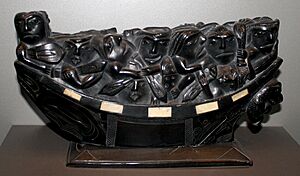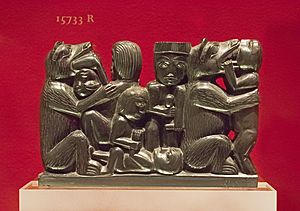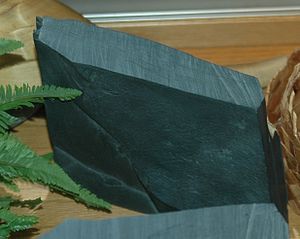Haida argillite carvings facts for kids

Haida argillite carvings are special sculptures made by the Haida people, an Indigenous nation from the Northwest Coast of North America. This art form became popular in the early 1800s and is still created today.
Contents
- What is Argillite Carving?
- Where is Argillite Found and What is it Made Of?
- How Argillite is Collected, Carved, and Stored
- How Haida Argillite Carving Might Have Started
- Changes in Argillite Carving Styles Over Time
- Timeline of Argillite Carving Styles
- Famous Haida Argillite Carvers
- Books to Learn More
What is Argillite Carving?

Argillite became a popular material for carving after the trade of sea otter fur slowed down in the early 1800s. These carvings allowed the Haida people to trade with European visitors. Because of this, argillite carvings are often seen as "tourist art". This means they were first made to be sold outside the Haida community to help the Haida earn money.
Sometimes, argillite carvings mix Haida and European styles. Traditional Haida images might be changed so they don't lose their deep cultural meanings when sold. These carvings also often included jokes or playful images about objects, animals, and even European culture.
The argillite used by the Haida comes from Haida Gwaii, which used to be called the Queen Charlotte Islands. The Haida people own the quarry (the place where the stone is dug up) and are the only ones allowed to use this special argillite for carving. Today, argillite carvings are sold in art galleries and stores and often show more traditional Haida designs.
Haida artists have been carving the black stone from Haida Gwaii for hundreds of years. The art has shown many different things, from traditional Haida shapes to Western figures. Even though it's been around for a long time, people have only studied Haida argillite carving closely in the last 30 to 40 years.
While it's often called "tourist art," argillite carving is much more than that. It has become very valuable to museums and private collectors. Experts from Canada and America have been studying argillite for many years. Argillite carving is still a strong art form today, and new styles will likely appear over time.
Where is Argillite Found and What is it Made Of?

Argillite is similar to a stone called catlinite, which was used by Indigenous peoples of the American Plains to carve ceremonial pipes. However, catlinite is reddish-brown because it has a lot of iron oxide. Argillite is dark grey to black because it has more carbon.
The argillite used by the Haida is found at the Slatechuck argillite quarry on Slatechuck Mountain. This mountain is near Skidegate on Graham Island in Haida Gwaii. In the Haida language, argillite is called kwawhlhal. The quarry is very hard to reach, and its exact location is a secret kept by those who know it.
Argillite is very important to the Haida people. Only the Haida have the right to use the type found at Slatechuck Creek, which isn't found anywhere else in the world. One of the first times the Slatechuck quarry was written about was around 1820. This was when people looking for coal or copper found a large amount of the black stone.
The argillite from the Slatechuck quarry is special because it doesn't have quartz or feldspar. It also has a very complex natural structure. This makes it different from other types of argillite. The Slatechuck argillite started forming about 70 million years ago. This happened when a hot vent in the earth's crust heated a layer of shale. This shale was made of kaolin and carbon. To the eye, argillite looks like other types of shale. But if you look closely with a microscope, you'll see it has a lot of natural materials trapped inside.
How Argillite is Collected, Carved, and Stored
Carvers usually like to collect argillite from the quarry themselves. But sometimes, groups of strong people who aren't carvers make the difficult trip. These trips often involve several people who bring back enough argillite for carvers to use for at least a year.
The collectors choose stone that looks free of cracks or flaws. A large slab, weighing up to 500-600 pounds (about 227-272 kilograms), is cut from the quarry. They use tools like a hand saw, steel wedge, sledgehammer, shovel, crowbar, and a long pole for leverage. The big slab is then cut into smaller pieces, each weighing between 50 and 100 pounds. These pieces are then slowly and carefully carried home.
Most carvers try to make a sculpture from one single piece of argillite. However, bigger pieces of argillite are more likely to break because of natural flaws. So, larger sculptures are sometimes made from separate pieces that are carved and then glued together.
Carvers often create raised designs (high relief) by carving against the grain of the stone. This makes the delicate argillite stronger. The downside is that it can sometimes cause the stone to flake. This makes high relief carving an advanced skill. For a long, shallow piece, it's often better to carve with the grain.
Different carvings need different skill levels. Panel pipes are thought to be the hardest to carve. Bowls are also challenging. Group figures, boxes, poles, and plates are considered easier.
The shiny black finish of argillite is usually not natural. When it's first dug up, argillite is often grey-black or green-black. The deep black color is created by the carver rubbing the carving with oils or polish as they work. The natural oils from skin actually help create the deep black color argillite is famous for. Sometimes, carvers also put a polish on the argillite to get that jet-black look.
Argillite is easier to carve when it's wet. So, after it's taken from the Slatechuck quarry, it's kept as moist as possible. It's often wrapped in damp cloth and stored in a moist place, sometimes even buried in the ground. Another way to keep it moist is to cover the uncarved argillite with a special sealant called Varathane. The drier the argillite gets, the more likely it is to flake or crack while being carved.
How Haida Argillite Carving Might Have Started

Knut Fladmark, an expert in Archaeology, thinks the Haida knew about argillite before Europeans arrived. He believes they used it for practical things like making labrets (lip ornaments). Fladmark found the first large collection of argillite items at a site on Graham Island.
His studies suggested that making argillite pieces for trade came after the Haida used it for pipes. The elbow pipes Fladmark found might be older than 1820, which is when argillite carving for sale is generally thought to have started. These early pipes had little decoration and seemed to be only for practical use. This makes them different from later, more artistic argillite pieces. Fladmark also found a labret that seemed to be made of argillite.
Another art historian, Robin Kathleen Wright, believes that the introduction of tobacco pipes to the Haida culture led to the first argillite carvings. European and American sailors brought smoking tobacco to the Haida. Argillite pipes that show signs of being smoked date from about 1810–1840. These early pipes are usually small but have large bowls. These very early argillite pieces show traditional Haida images. These images were usually seen on totem poles, masks, rattles, and spoon handles.
Haida art has always shown images of rank, family history (lineage), and status. It can be seen as a way to record history for a society that had no written language. Selling argillite carvings seems to have started in the 1820s when it became a valuable trade item. During this time, the Haida didn't seem to use argillite for anything other than carving.
For the Haida, argillite was perhaps part of a move towards earning more money. Getting more wealth became more important during the 1800s, and selling argillite helped with this. Before 1820, no argillite carvings were found in any public or private collections. The shift to argillite carving also happened because the number of sea otters was decreasing, which meant less trade in sea otter furs.
Changes in Argillite Carving Styles Over Time
Early Ideas About Style Changes
Marius Barbeau, a Canadian expert, was one of the first to study argillite art in detail. He thought argillite carving started because the Haida saw whalers' scrimshaw (carvings on whalebone or ivory). However, later researchers noted that scrimshaw wasn't introduced to the Haida until about 20 years after argillite carving began. Barbeau also believed that argillite carving only changed to a new style around 1870. This was when more traditional Haida themes started to replace Western styles. But in his research, Barbeau missed the very first argillite carvings, which used only traditional Haida images.
Different Periods of Style
Carole Kaufmann, an art historian, greatly helped us understand Haida argillite carving. She looked at how society and culture influenced the carving styles.
Her first period, called Haida I (around 1820 to 1830), was a time of trying out this new material. Argillite carvings at this time were similar to carvings made from wood.
The second period, called the Western Period, began in 1830. This is when argillite carvings started to include Western ideas and themes. Kaufmann disagreed with the idea that this change was because European buyers wanted Western-themed carvings. She also didn't agree with the theory that whalers' scrimshaw inspired Western-themed argillite carving. Kaufmann thought that the move towards Western images in the 1830s showed that the Haida were open to European culture. They wanted to bring more of the Western way of life into their own world.
Both the first and second periods (1820 to about 1865) are similar because none of the carved items were sacred. Instead, all argillite carvings made during this time were practical and not religious.
The third period, Haida II, started in 1870. This period saw a return to Haida-inspired images, themes, and styles. This return to more traditional images has been seen as a sign that Haida society was becoming more stable. This was partly because there were fewer whalers and traders in the area. However, Kaufmann believed this change was actually caused by the breakdown of social and artistic rules. The Haida population had been greatly reduced by diseases, increased travel, and missionary influences. This meant the old rules for making important cultural objects and images started to weaken. According to Kaufmann, seeing sacred images in argillite showed "a loosening within the traditional social structure."
Robin Kathleen Wright, another American art historian, built on Kaufmann's ideas. She focused on Haida argillite pipes. Wright suggested that the introduction of tobacco pipes helped start argillite carving. She also successfully linked Western influences on Haida culture to their effects on argillite styles.
Wilson Duff's "Sense" and "Non-Sense" Ideas
Wilson Duff, a Canadian expert, noticed some issues with the theories about how Haida argillite carving styles changed. Duff looked at the history of argillite carving again. He created a timeline based on what he called "sense" and "non-sense." Instead of Kaufmann's three periods, Duff divided the history of argillite carving into four phases. He used Kaufmann's first three phases and added a fourth, which he then split into two parts.
Duff's first period (1800–1835) was a "non-sense" period. This means the traditional Haida images or themes didn't seem to be put together in a logical way. Duff thought these illogical carvings were because the Haida didn't want important parts of their culture to be owned by Europeans.
Duff's second period (1830–1865) was called "White Man’s Non-sense." During this time, many argillite carvings showed Europeans or Americans. These were often carved in a more Western style. This shift towards Western styles and themes might have been due to more contact between the two cultures. There were also many mixed images and visual jokes during this period. This "non-sense" theme also showed the Haida making fun of Western culture's seeming lack of logic.
The way Western culture was shown became more detailed during this time. By 1865, there were common ways the Haida showed Western clothing. They also started mixing traditional and Western ways of showing figures.
The third period (1865–1910) was a "Haida sense" period. This meant a return to strong traditional themes in argillite carving. This was likely because the Haida population and culture were decreasing at the time. Meaning suddenly became clear in argillite carvings. Important Haida figures like chiefs and shamans, and sacred themes, appeared. Haida myths, like the Bear-Mother myth, started to be shown in the carvings. Duff saw this period as the Haida's attempt to record parts of their culture that were quickly being forgotten due to religious changes or deaths. By 1910, argillite carving started to decline as more Haida people and culture were lost.
Duff's fourth period (1910–1981) was called "Haida-Sense II." This was the longest period in his model. Many great Haida artists from the third period died in the early years of the fourth period. This led to a lack of skilled carvers and a pause in argillite carving. This first part of period four was what Duff called "The Plateau Era." This era ended with a nationwide cultural revival in the 1960s among Native American communities. This revival aimed to bring back traditional cultural practices. New argillite carvers looked to older carvers, universities, museums, and galleries to learn how to carve.
Timeline of Argillite Carving Styles
- 1820: Oval pipes and pipe panels are the most popular argillite carvings.
- 1830: Pipe panels become more popular than oval pipes. This change happens as more Western-style images appear. Single figures and Western-type pipes also start to show up.
- 1840: Fewer oval pipes are made. Pipe panels and panel forms are common. Single figures usually show American or European men.
- 1840–1860: Buyers prefer dishes, flutes, and other tools.
- 1865: A big change happens. Totem poles and house posts start to appear. This begins a time when more traditional images are used in argillite carving. Very few Western-themed carvings are seen after this date.
- 1870: Traditional Indigenous themes continue to increase. The first flat house posts are seen, and free-standing house posts become more popular after 1875.
- 1880: More types of objects appear around this time. Carvings with multiple figures also become most common.
- 1890: Pipes become popular again, but with more decoration. The popularity of individual single figures also increases. Totem pole models continue to be sought after, a trend that continues today.
- 1900–1910: Steady production of figures and poles.
- 1910–1960: Most items made are small (6 inches or less). Only a few artists carve large pieces. Poles are made and sold to stores and galleries.
- 1960: Interest in Native American cultural revival causes an increase in argillite carving of all shapes and sizes.
Famous Haida Argillite Carvers
- Charles Edenshaw
- Bill Reid
- Claude Davidson
- Jay Simeon
- Gary Minaker Russ
- Rufus Moody
- Christian White
- Darrell White
- Tom Hans
Books to Learn More
- Leslie Drew and Doug Wilson. Argillite: Art of the Haida. Surrey, B.C.: Hancock House, 2003. ISBN: 978-0-88839-037-0

